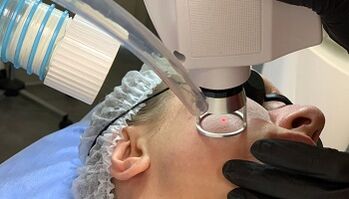
Aging is a natural biological process that affects all tissues of the human body. Particularly exposed to the parts of the body that make up a person’s external appearance.
For example, facial tissues are constantly exposed to environmental factors, as well as facial function, chewing and speech.
The issue of maintaining facial youth is very important and relevant, as it is a kind of "visitor card" of a person.
Today there are many methods to solve this problem, but laser facial rejuvenation, according to reviews, requires special attention.
Mechanism of action of laser on the skin
The essence of the method is the fractional effect of the laser beam on the skin. The laser beam, by splitting into many very thin rays, acts on the microscopic area of the skin and evaporates it. The area of action of the laser is located at a strictly specified depth. Intact cells, located between the zones of laser beam exposure, begin the active production of two main "building blocks"-elastin and collagen, because as we age, these substances in the human body are almost never formed independently.
After the laser facial rejuvenation procedure, skin tone improves, bags under the eyes are removed, medium and fine wrinkles disappear or are corrected, facial contours are tightened. In addition, this method is used to improve the outcome of surgical interventions (e. g. , in plastic surgery), as well as for the laser surface of the skin.
Fractional laser facial rejuvenation type
Depending on the depth and nature of the penetration of the laser beam into the skin, there are two types of procedures:
- Ablative fractional laser rejuvenation, when the micro areas of the skin are removed, and then, in the process of gradual healing, the damaged micro zones are tightened. The lifting effect was observed after the first procedure;
- Non-ablative fractional facial rejuvenation, when collagen and elastin are also renewed in the damaged area, but the process takes place on the deep layers of the skin, where the laser beam penetrates without damaging the outer layers. As a result of this procedure, the rejuvenation process takes longer.
Optimal technique variants can be suggested by experts, but, according to reviews, with laser facial rejuvenation, it is most effective to combine different types of procedures so that cell renewal occurs not only on the skin surface, but also in deeper layers.
Advantages of Fractional Laser Facial Rejuvenation
Fractional laser rejuvenation, compared to classical methods, has a number of advantages.
First, the effect on the skin is precise, which means that the damage is minimal. Thanks to this, all traces of the procedure disappear for 3-4 days after the intervention.
Second, in one session it is possible to treat large areas of skin, while its source of regeneration is not only preserved, but also activated, which ensures quick recovery and long -term positive effects.
Third, this procedure does not require anesthesia, and can be performed easily on the skin in the décolleté, neck and eye areas.
And fourth, side effects are rare. The possibility of complications in the form of red spots in the area of action, slight itching, peeling, burns or crusts on the skin quickly disappears. Scarring, hypo and hyperpigmentation are extremely rare.
Although there are listed advantages, before performing the procedure, it is necessary to familiarize yourself with the indications and contraindications for laser facial rejuvenation.
Instructions for laser rejuvenation
During its existence, this method has proven its effectiveness, but the effect will be very noticeable if there are the following skin problems:
- Spider veins;
- Scars;
- Stretch marks;
- Enlarged pores;
- Pigmentation;
- Acne;
- Wrinkles;
- Skin loose, sagging, faded;
- Crow's feet surround the eyes.
If there is a problem from the relevant suggested list, fractional laser facial rejuvenation will help overcome it.
Contraindications to laser facial rejuvenation
In addition to the clear instructions, there are also absolute contraindications to the procedure:
- Inflammatory processes in the affected area;
- Dermatosis and psoriasis;
- The tendency to form tumor -like scars;
- Focus herpes in the affected area;
- Cases of vitiligo in close relatives;
- Chemical peels are performed less than 2 weeks before the proposed procedure;
- Systemic blood diseases;
- Varicose veins in the laser area;
- Pregnancy and lactation;
- Oncological diseases;
- Severe forms of coronary heart disease and hypertension.
A relative contraindication to laser facial rejuvenation is the presence of fresh, simple and superficial skin less than 3 weeks before the procedure.
The course and action of laser rejuvenation afterwards

Depending on the area of skin being treated and the nature of the problem, the duration of one fractional laser exposure session is from 20 to 40 minutes. Repeated procedures are possible only after 3 or 4 weeks, and overall, usually, 3-4 sessions are required. Within three months of completing the course, the maximum positive effect can be seen. To maintain this, it is recommended to hold repeated sessions once a year.
After the procedure, you may feel a slight burning sensation, but it will go away within 1-2 hours. The resulting redness and the possibility of slight swelling persists for 1-3 days. Currently, it is recommended to use external agents containing depanthenol (for example, ointments or gels). Once the listed symptoms disappear, it is necessary to use a cream containing hyaluronic acid.
You can wash and shower on the same day when the laser facial rejuvenation is done, but it is better to postpone a visit to the pool or sauna. The day after the procedure, you can use the foundation again.
The use of sunscreen with SPF 30 or higher is mandatory, as skin is very sensitive to UV rays at this time.
After laser rejuvenation, you should follow the recommendations of the specialist who performed the procedure. The doctor, depending on the type and characteristics of the skin, will recommend the optimal cosmetic preparation, as well as determine the frequency and duration of its use.
























